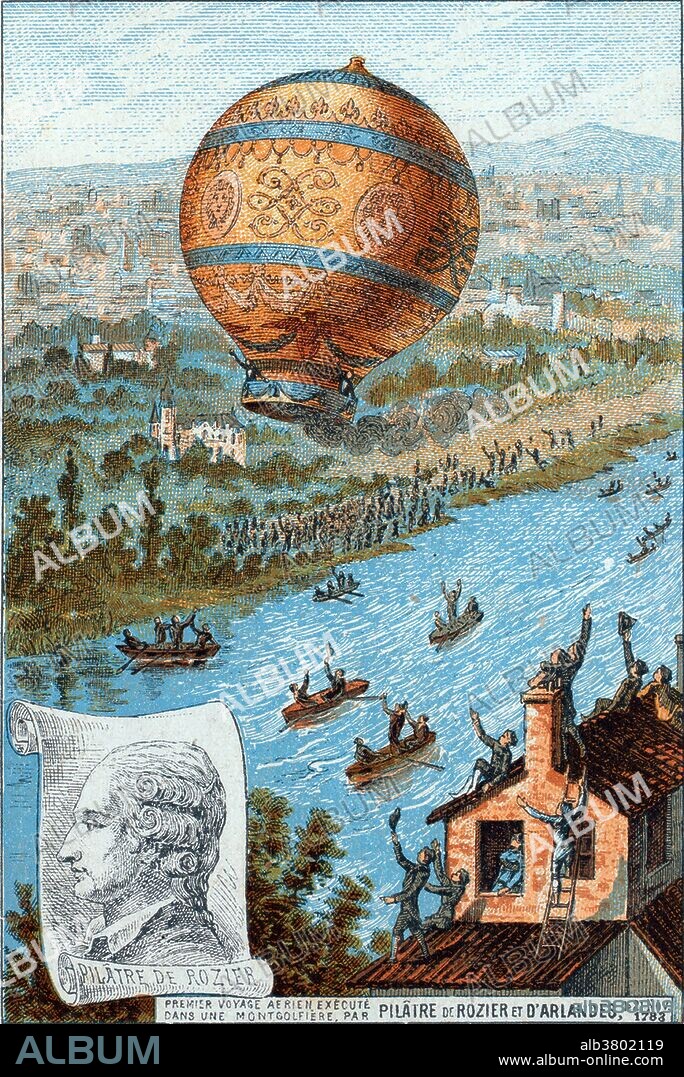alb3802119
First Untethered Balloon Flight, 1783

|
Añadir a otro lightbox |
|
Añadir a otro lightbox |



¿Ya tienes cuenta? Iniciar sesión
¿No tienes cuenta? Regístrate
Compra esta imagen.
Selecciona el uso:

Título:
First Untethered Balloon Flight, 1783
Descripción:
Ver traducción automática
The first untethered balloon flight, by Pilatre de Rozier and the Marquis d'Arlandes on November 21, 1783. Their 25 minute flight travelled slowly about 5.5 miles to the southeast, attaining an altitude of 3,000 feet, before returning to the ground at the Butte-aux-Cailles. Jean-Pierre Blanchard (July 4, 1753 - March 7, 1809) was a French inventor. He is most remembered as a pioneer in aviation and ballooning. He made his first successful balloon flight in Paris on March 2, 1784, in a hydrogen gas balloon launched from the Champ de Mars. On January 7, 1785 Blanchard, accompanied by an American, Doctor John Jeffries, made the first flight over the English Channel, taking about 2.5 hours to travel from England to France. He toured Europe, demonstrating his balloons. He holds the record of first balloon flights in Belgium, Germany, the Netherlands, and Poland. In 1793, he conducted the first balloon flight in North America, ascending from Philadelphia, Pennsylvania and landing in Deptford, New Jersey. Witnesses that day included President George Washington, and the future presidents John Adams, Thomas Jefferson, James Madison, and James Monroe. He married Marie Madeleine-Sophie Armant in 1804. In 1808, he had a heart attack while in his balloon at the Hague. He fell from his balloon and died in 1809, at the age of 55, from his severe injuries. His widow continued to support herself with ballooning demonstrations until it also killed her.
Crédito:
Album / LOC/Science Source
Autorizaciones:
Tamaño imagen:
2700 x 4043 px | 31.2 MB
Tamaño impresión:
22.9 x 34.2 cm | 9.0 x 13.5 in (300 dpi)
Palabras clave:
1783 • AERONAUTA • AERONAUTICA • AERONAVE • AEROSTACION • APARATO DE OXÍGENO • ARTE • AVIACION • AVION • AVIONES • CIENCIA • CROMOLITOGRAFIA • DIBUJO • DIRIGIBLE • EUROPEA • EUROPEAS • EUROPEO • EUROPEOS • FAMOSA • FAMOSO • FIGURA • FRANCES • GENTE • GLOBO AEROSTATICO • HISTORIA • HISTORICO • HOMBRE • HOMBRES • ILUSTRACION • IMPORTANTE • INVENCION • INVENTOR • LITOGRAFIA • MASCULINO • OBRA DE ARTE • PERSONA • PERSONALIDAD • PERSONALIDADES • POSTAL • PROFESOR • QUIMICO • RETRATO DE HOMBRE • S. XVIII • SIGLO XVIII • TARJETA POSTAL • TECNOLOGÍA • VIAJAR EN GLOBO • VOLADOR • VUELO • ZEPELIN
 Pinterest
Pinterest Twitter
Twitter Facebook
Facebook Copiar enlace
Copiar enlace Email
Email
